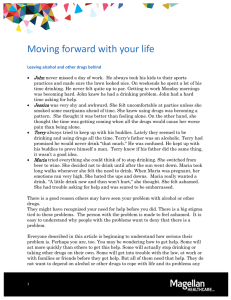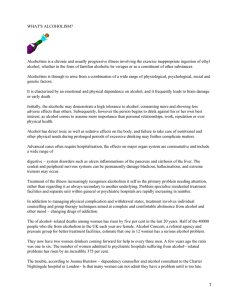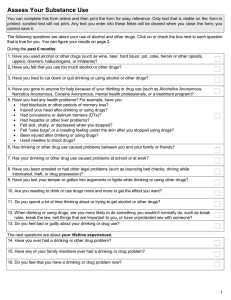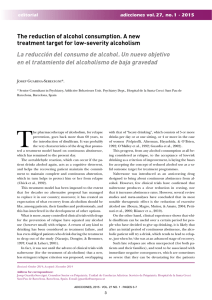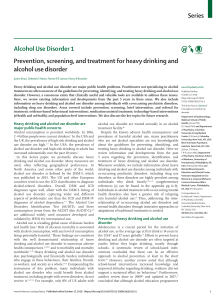Blood Alcohol Level tests in nightlife recreational settings as a
Anuncio
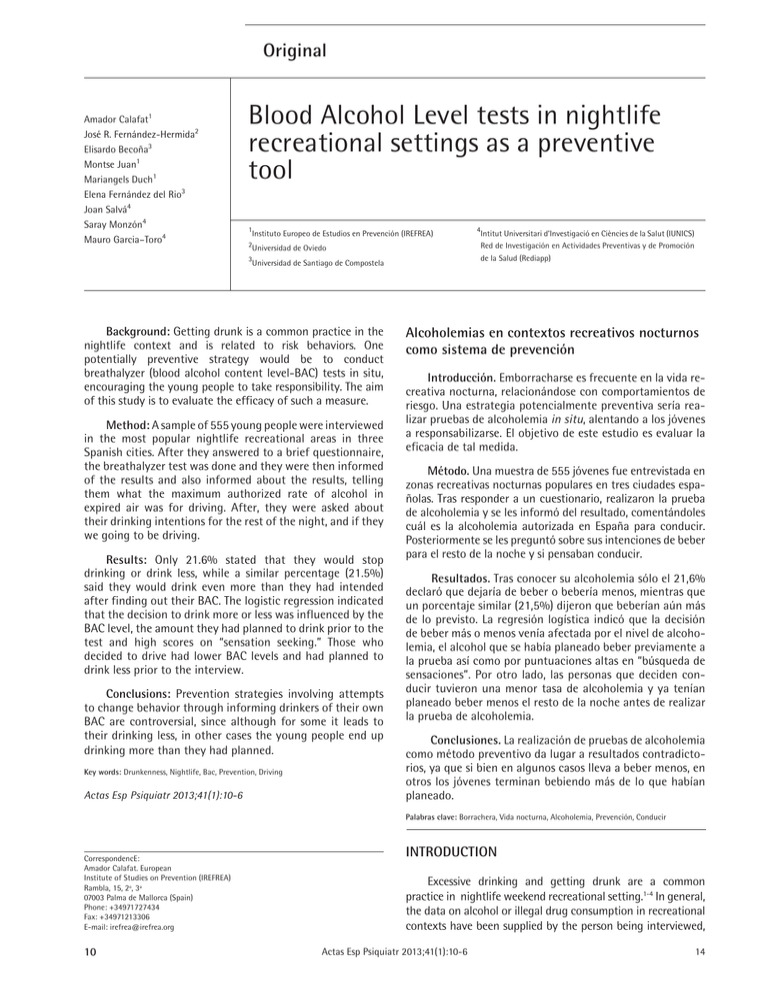
Original Amador Calafat1 José R. Fernández-Hermida2 Elisardo Becoña3 Montse Juan1 Mariangels Duch1 Elena Fernández del Rio3 Joan Salvá4 Saray Monzón4 Mauro Garcia–Toro4 Blood Alcohol Level tests in nightlife recreational settings as a preventive tool 1 Instituto Europeo de Estudios en Prevención (IREFREA) 2 Universidad de Oviedo 3 Universidad de Santiago de Compostela Background: Getting drunk is a common practice in the nightlife context and is related to risk behaviors. One potentially preventive strategy would be to conduct breathalyzer (blood alcohol content level-BAC) tests in situ, encouraging the young people to take responsibility. The aim of this study is to evaluate the efficacy of such a measure. Method: A sample of 555 young people were interviewed in the most popular nightlife recreational areas in three Spanish cities. After they answered to a brief questionnaire, the breathalyzer test was done and they were then informed of the results and also informed about the results, telling them what the maximum authorized rate of alcohol in expired air was for driving. After, they were asked about their drinking intentions for the rest of the night, and if they we going to be driving. Results: Only 21.6% stated that they would stop drinking or drink less, while a similar percentage (21.5%) said they would drink even more than they had intended after finding out their BAC. The logistic regression indicated that the decision to drink more or less was influenced by the BAC level, the amount they had planned to drink prior to the test and high scores on “sensation seeking.” Those who decided to drive had lower BAC levels and had planned to drink less prior to the interview. Conclusions: Prevention strategies involving attempts to change behavior through informing drinkers of their own BAC are controversial, since although for some it leads to their drinking less, in other cases the young people end up drinking more than they had planned. Key words: Drunkenness, Nightlife, Bac, Prevention, Driving Actas Esp Psiquiatr 2013;41(1):10-6 4 Intitut Universitari d’Investigació en Ciències de la Salut (IUNICS) Red de Investigación en Actividades Preventivas y de Promoción de la Salud (Rediapp) Alcoholemias en contextos recreativos nocturnos como sistema de prevención Introducción. Emborracharse es frecuente en la vida recreativa nocturna, relacionándose con comportamientos de riesgo. Una estrategia potencialmente preventiva sería realizar pruebas de alcoholemia in situ, alentando a los jóvenes a responsabilizarse. El objetivo de este estudio es evaluar la eficacia de tal medida. Método. Una muestra de 555 jóvenes fue entrevistada en zonas recreativas nocturnas populares en tres ciudades españolas. Tras responder a un cuestionario, realizaron la prueba de alcoholemia y se les informó del resultado, comentándoles cuál es la alcoholemia autorizada en España para conducir. Posteriormente se les preguntó sobre sus intenciones de beber para el resto de la noche y si pensaban conducir. Resultados. Tras conocer su alcoholemia sólo el 21,6% declaró que dejaría de beber o bebería menos, mientras que un porcentaje similar (21,5%) dijeron que beberían aún más de lo previsto. La regresión logística indicó que la decisión de beber más o menos venía afectada por el nivel de alcoholemia, el alcohol que se había planeado beber previamente a la prueba así como por puntuaciones altas en “búsqueda de sensaciones”. Por otro lado, las personas que deciden conducir tuvieron una menor tasa de alcoholemia y ya tenían planeado beber menos el resto de la noche antes de realizar la prueba de alcoholemia. Conclusiones. La realización de pruebas de alcoholemia como método preventivo da lugar a resultados contradictorios, ya que si bien en algunos casos lleva a beber menos, en otros los jóvenes terminan bebiendo más de lo que habían planeado. Palabras clave: Borrachera, Vida nocturna, Alcoholemia, Prevención, Conducir CorrespondencE: Amador Calafat. European Institute of Studies on Prevention (IREFREA) Rambla, 15, 2º, 3ª 07003 Palma de Mallorca (Spain) Phone: +34971727434 Fax: +34971213306 E-mail: irefrea@irefrea.org 10 INTRODUCTION Excessive drinking and getting drunk are a common practice in nightlife weekend recreational setting.1-4 In general, the data on alcohol or illegal drug consumption in recreational contexts have been supplied by the person being interviewed, Actas Esp Psiquiatr 2013;41(1):10-6 14 Amador Calafat, et al. Blood Alcohol Level tests in nightlife recreational settings as a preventive tool which may generate reliability problems.4,5 On the other hand, being drunk does not necessarily have the same meaning for different individuals or in different contexts or cultures.6,7,8 That is why it is important to have reliable methods to verify the true intoxication level, such as the blood alcohol level. The amount of drinks had, beyond the possible omissions, especially if the subject has drunk a lot,4 may result in different blood alcohol levels based on gender, body mass, time in which the drink was had, having eaten, etc.. objective measurement of their own consumption, with a view to possible preventive actions. The study replicates some points of another similar study conducted with an English population.16 As reference measurement, we used a blood alcohol level of 0.05% since that is the legal limit in Spain. A regular deterioration of behavior was observed with blood alcohol levels of 0.05%. This generally increased progressively after this concentration.24 Consumption of alcohol and illegal drugs in the recreational context is related to different risk behaviors. These may be violence,2,9,10 at risk sexuality,11 driving under the effects of alcohol or drugs.2,12 Given that most of the at risk consumption of alcohol and illicit drugs by the young occurs in the nighttime recreational contexts, preventing these contexts becomes one of the principal challenges.13 Actions aimed at drinking binge arising problems attempt to avoid the associated risk behaviors. These actions may be, for example, programs of designated driver14 or advising the subject to alternative alcoholic drinks with non-alcoholic drinks. However, they sometimes try to affect global consumption or indicate alcohol limits to drink in each session.15 Few efforts have been made to directly affect the underlying cause of many of these problems, which is precisely the excessive frequency of drinking binges.16 METHOD To be able to decrease drunkenness or binge drinking based on the awareness of the persons per se who abuse requires complex strategies that begin with better knowledge of motivations to consume.17,18 Studies that analyzed motivations to drink two weeks prior to controlling consumption concluded that those who abuse alcohol on week-end nights do so because they seek fun and emotions.19,20 The importance given to having fun by the consumers in the recreational context exceeds the value given to maintenance of long-term health.21 In a work that informed young people in recreational situations about blood alcohol level and told them, as a reference, if they exceeded the blood alcohol level limit permitted in the UK or not, only 3.55% of the individuals stated they would drink less as a result of knowing their blood alcohol level, 24.87% said they would still drink and 71.57% commented that knowledge of their blood alcohol level would not affect what they considered drinking.16 In a sample of 6,615 young people in recreational context in Italy, approximately 34% had levels greater than the rate permitted to drink in Italy (0.5%).22 A qualitative work investigated how adolescents considered the meaning of the negative incidents related with alcohol abuse that they themselves had experienced or had seen. Even when they evaluated this somewhat negatively, it did not seem to affect their consumption patterns.23 The present study aimed to investigate the response of a sample of Spanish youth in recreational contexts regarding some of the following questions, such as reaction to an 15 Sample and procedure The study took place in 3 Spanish cities (Oviedo, Palma de Mallorca and Santiago de Compostela). The most popular nocturnal recreational area was chosen in each city. The teams, made up of two interviewers, were located in an area close to the recreational sites. Randomly (one of every 5 persons who passed through a certain point were chosen), the young people were invited to participate. If they were in a group, only one of them was interviewed. First of all, the person was asked if they wanted to participate in a study. If they accepted, they were given an explanation about what the study consisted in. This first approach also served to confirm the inclusion conditions (to be younger than 30, be a resident in the city and not be too drunk so that they could not understand the questions). If these conditions were met and they accepted (informed consent), the survey and an alcoholmeter test were made. Following this, the subjects were informed about the result and reminded that the authorized maximum rate of aspired air to be able to drive is 0.025% (this corresponds to 0.05% in blood). Once they were informed, they were asked three questions that made it possible to evaluate their reaction. The interviews were made between 12 a.m. and 6 a.m. during the spring of 2011 (between April and May). The three teams had a manual, the same questionnaire, and data collection protocols. The interviewers, all psychologists, had been trained both in the skills needed to assure that the survey would be adequately answered and in the use of the alcoholmeter. According to the time range, 35.21% of the interviews were made between 12.00 a.m. and 2.00 a.m., 37.64% between 2.01 a.m. and 4.00 a.m., and 27.15% between 4.01 a.m. and 6.00 a.m. Prior to initiating the interview, the perceived level of drunkenness was written down. Those whose drunkenness made it impossible to understand the questions and study purpose were ruled out. The investigators addressed a total of 1,860 young, potential participants. A total of 31.8% did not want to know anything about it or did not even stop to know what the study was going to be about. Another 19.8% did not agree to participate in the study, leaving before the survey had been initiated and 18.5% of the total sample were Actas Esp Psiquiatr 2013;41(1):10-6 11 Amador Calafat, et al. Blood Alcohol Level tests in nightlife recreational settings as a preventive tool excluded for different reasons. These reasons were not being residents (tourists or Erasmus program students), being too drunk, consuming alcohol at that moment (and not wanting to wait the 20 minutes needed before being able to perform the blood alcohol level test), being over 30 years, or not having had anything to drink in the whole night. A total of 555 young persons, 29.8% of the total number of youths approached, agreed to participate. By cities, 27.7% corresponded to Santiago de Compostela, another 27.7% to Oviedo, and 44.5% to Palma de Mallorca. After answering the first 22 questions, the participants took the alcohol test (Lion Alcoholmeter 500). After, the interviewed person was given the results and filled out the questionnaire. Eighteen questionnaires were ruled out for different reasons in the data entry: age, incomplete, illegible, or clearing inconsistent data. The final data was made up of 537 individuals: 149 surveyed in Oviedo, 149 in Santiago de Compostela and 239 in Palma de Mallorca. Instrument Blood alcohol level The questionnaire is based on another similar one used in previous investigations in the UK for similar populations.16 However, this questionnaire contains changes. It incorporates 26 questions (4 having socio-demographic character, 13 on styles of recreation, which include types and amounts of consumption made, when and where consumed, expectations on consumption for the rest of the night, time they expected to return home, if they planned to drive, preferred sites, etc., four that are made up by the Brief Sensation Seeking Scale (BSSS-8), a brief scale on sensation seeking validated in Spanish and used much in epidemiological studies,25 three more questions made a posteriori, once the alcoholmeter test is completed and they have been informed of the result obtained, and finally two more questions on driving). Mean blood alcohol level in the whole sample was 0.058%. We consider 0.025% as dangerous blood alcohol level in expired air, this corresponding to 0.05% in blood. Persons with this blood alcohol level or superior are not allowed to drive in Spain and in other European countries (countries as the United Kingdom and the USA permit blood alcohol level up to 0.08%), although persons who have had their driver’s license for less than two years have a maximum permitted level in Spain of 0.3%. Young persons who exceeded the rate permitted (0.025% in aspirated air, that is, 0.05% in blood) accounted for 63% of the sample in Oviedo, 54.5% in Santiago de Compostela and 44.4% in Palma. More than half of the sample exceeded this level. Consequences for alcohol consumption derived from knowing the blood alcohol Analysis The data were analyzed using the SPSS v. 15 program. The statistical analyses made were bivariate and multivariate. Included among the former are the chi-square for discrete variables and the Student’s t test for continuous variables. In both cases, the effect size was calculated, using the Cramer Phi for chi-square and the Cohen D for the Student’s t. As multivariate analysis, the binary logistic regression was used with block entry of variables in the initiation of the analysis. RESULTS Sociodemographic data Distribution by gender was 59.8% men and 40.2% women. By age, those under 18 years accounted for 6.54%; 12 those between 18-19 years for 23.18%, between 20-24 years 42.43% and those between 25-30 years accounted for 27.35% of the sample. Distribution by gender according to age groups showed statistically significant differences (p=0.005). There were more women among the younger age groups and fewer among those over 25 years. The study level of the participants was 21% with basic studies, 32 secondary level, and 9.7% who had completed vocational training (VT) and 37.1% who had university studies. Distribution by studies did not show statistically significant differences for gender but did so for age (p=0.001). A total of 65.20% lived with their parents, without statistical differences by gender. Most (71.93%) stated they had a good relation with their parents, 13% had a regular one and only 4.87% said they had a bad relation (without statistically significant differences regarding gender or age). Only 12.10% had set up a time to come home with their parents, there being no statistically significant differences regarding gender or age (p=0.001). When the subjects were told about their blood alcohol levels, explaining how much they were above or below the permitted level for driving, they were asked if they were going to increase, decrease or stop consuming alcohol in regards to what they had planned to do. A total of 15% stated they would stop drinking and 6.5% that they would drink less than usual. However, 21.5% decided they would drink more while 56.8% stated that knowing their blood alcohol level would not affect their behavior. In short, the possibilities of having a positive reaction are greater (Chi square with correction for continuity=6.857, p=0.009, ɸ=0.118) if the blood alcohol level is above 0.25 mg/l in expired air. However, this relation does not seem very strong and is not the same in both genders. Only the Actas Esp Psiquiatr 2013;41(1):10-6 16 Amador Calafat, et al. Table 1 Blood Alcohol Level tests in nightlife recreational settings as a preventive tool Logistic regression for the variable - change of intention in alcohol consumption after learning the results of the blood alcohol level test B S.E. Wald Blood alcohol level test result 1.023 0.308 11.004 Gender 0.258 0.290 Sensation seeking 0.083 Alcohol already consumed 0.014 Alcohol that one plans to consume the rest of the night Times getting drunk in last month Variables in the equation Fights in last month Evaluation relation with parents p OR OR (95% C.I.) 0.001 2.781 1.520-5.088 0.794 0.373 1.295 0.734-2.284 0.040 4.248 0.039 1.087 1.004-1.176 0.021 0.424 0.515 1.014 0.973-1.056 0.264 0.086 9.356 0.002 1.302 1.099-1.542 0.144 0.074 3.785 0.052 1.155 0.999-1.335 0.000 0.114 0.000 0.998 1.000 0.801-1.250 -0.297 0.175 2.880 0.090 0.743 0.528-1.047 S.E. = standard error. B = intercept women “respond positively” when they know the higher level of blood (Chi square with correction for continuity=16.126, p < 0.000, ɸ=0.284), even though the blood alcohol level is not linked to gender (t=0.688, p=0.492). Several items do not show a relation with intention to drink less after knowing the level of alcohol in blood (age, level of studies, previous consumption, sensation of feeling drunk, or declaring that the person has driven on other occasions under the effects of alcohol or drugs). A total of 31% of those surveyed declared that they had driven under the effects of alcohol or drugs during the last year. Intention to consume less does not seem to be related to the fact of whether the person is going to have to drive home. There is also no relation with the intension to consume illegal drugs, the time foreseen to return home, living with parents or the amount of time the person has been drinking. On the contrary, there is a statistical relation between time drinking and blood alcohol level (the correlation between both measurements is 0.285, with a p<0.000). There are severe items that are related with the decision to drink less. Those who state they are going to drink less after they learn their alcohol blood level had already indicated it prior to the blood alcohol level test (t=-6.888, p<0.000, d=0.52). In an inverse sense, those who had been drunk during the last month had more possibilities (t=-3.879, p<0.000, d=0.32) of having a negative reaction, that is, of deciding to drink more or that it does not affect them. Having participated in fights also an influence (t=-2.135, p=0.03, d=0.12) having a negative reaction (to continue drinking the same or more), although the relation is weak, as well as having a bad relation with their parents (t=2.235, p=0.027, d=0.26) or being impulsive (t=-3.504, p<0.000, d=0.37). 17 Logistic regression (Table 1) We conducted a logistic regression in search of the variables that most influence change of intension of alcohol consumption after knowing the blood alcohol level test results, using the variables that have been significant in the bivariate analysis. The “positive” reaction was used as reference compared to the “negative” reaction. Blood alcohol level and intention about future consumption for the rest of the night expressed before the blood alcohol level test is performed also had a clearer influence. Sensation seeking had a limited, but significant, influence (Table 1). Driving home related with alcohol consumption Those who were not going to drive accounted for 442 (82.8%) of those interviewed while 92 (17.2%) were going to do so. Intention to return home driving is more frequent among males (21.3%) than among women (11.2%). At the time of the survey, the blood alcohol level was greater than 0.25 mg/L in 40.7% of those who were going to drive. There was no relation between intention to drive and previous alcohol consumption. However, there was with the alcohol consumption that they planned to drink during the rest of the night (t=2.076, p=0.038, d=0.24) and also with the result of the alcohol breathalyzer test (t=3.236, p=0.001, d=0.37). In both cases, those who were going to drive had lower alcohol blood level and were planning to consume less alcohol the rest of the night. The relation between alcohol breatalyzer and intention to drive is stronger among the women than in the men (women: t=2.264, p=0.025, d=0.49; men: t=2.517, p=0.012, d=0.35), if we follow Cohen’s d. Actas Esp Psiquiatr 2013;41(1):10-6 13 Amador Calafat, et al. Table 2 Blood Alcohol Level tests in nightlife recreational settings as a preventive tool Regresión logística para la variable criterio de regresar a casa conduciendo (en función del sexo) Variable Gender B S.E. Wald p OR -0.160 0.057 7.953 0.005 0.852 OR (95% C.I.) Future alcohol consumption Man Woman -0.003 0.086 0.002 0.969 0.997 0.841-1.181 Blood alcohol level test result Man -1.722 0.726 5.624 0.018 0.179 0.043-0.742 Woman -2.985 1.338 4.980 0.026 0.051 0.004-0.695 Other drug before blood alcohol level test Man -0.325 0.451 0.518 0.472 0.723 0.298-1.750 Woman -0.745 0.858 0.754 0.385 0.475 0.088-2.553 Other drug after blood alcohol level test Man -0.576 0.525 1.200 0.273 0.562 0.201-1.575 Woman 0.136 1.138 0.014 0.905 1.145 0.123-10.648 Sensation seeking Man 0.077 0.041 3.582 0.058 1.080 0.997-1.170 Woman 0.020 0.059 0.110 0.740 1.020 0.908-1.145 Those who stated they were going to drive had more likelihood of having consumed an illegal drug at the time of the survey (Chi square with correction for continuity=6.341, p=0.007, ɸ=0.117). A total of 20% of those who were going to drive indicated they had consumed another drug other than alcohol, compared to 10% of those who had to drive. Of those who stated they had consumed another drug, 33% indicated cannabis, as principal substance, and another similar proportion indicated cocaine. On the other hand, those who were going to drive had higher scores on sensation seeking (t=-2.072, p=0.04, d=0.24) but had not become drunk or had a fight more in the last month. When a logistic regression with the variables that were significant in the bivariate analysis is performed separately by gender, the total percentage of the variance explained was only 11.3% in men and 6.5% in women. Many variables did not show a significant relation nor had a reduced odds ratio (See Table 2). The variables that were significant were blood alcohol level found (persons with higher levels tended to drive less) and amount of alcohol that they aimed to consume during the rest of the night prior to the blood alcohol level test, only in the case of the men (Table 2). DISCUSSION Measurement of blood alcohol level found in the study among the young people interviewed was 0.058% in blood, that is, above the level permitted to drive in Spain and in most other European countries. It is important that there was no significant relation between blood alcohol level reached and gender in our study, on the contrary to other studies in which the males had higher blood alcohol levels.4,16 The effects of alcohol on women are greater.26 Women generally show greater involvement of behavior in all the 14 0.762-0.952 areas, and greater subjective sensation of being drunk than men for the same blood alcohol level.27 The blood alcohol level test was communicated to each person, using 0.05% as reference to orient them. In spite of this, it does not seem that knowledge of blood alcohol level reached and its implication had a positive influence on consumption in our study. Only 15% said they would stop drinking during the rest of the night and 6.6% more that they would drink less than initially foreseen, while 21.5% said that they would drink more than foreseen and 56.7% that knowing it did not affect them. If this relation is studied based on gender, it is seen that the women react more positively (stopping or reducing alcohol consumption) on knowing the blood alcohol level test results while the knowledge of this information did not seem to have any influence in the men. It is true that the data are more positive than in another study with similar methodology, but with an English sample,16 in which only 3.55% indicated they would drink less the rest of the night. However, it is true that the percentage of those who said they would drink more (24.87%) as a consequence of knowing the blood alcohol level is quite similar to our study. In accordance with the logistic regression (Table 1), a higher blood alcohol level is related (odds ratio 2.781) with deciding whether to drink less or to stop drinking for the rest of the night, but simultaneously, and with the same odds ratio, with the decision to drink more or to not pay attention to the information received on the results of the blood alcohol level test (since one serves as a reference for the other to make the logistic regression). The blood alcohol level test in the Bellis study16 did not affect type of decision. However, a relation was found in another English study in which those who aimed to continue drinking had higher levels of alcohol in blood,4 perhaps because high blood Actas Esp Psiquiatr 2013;41(1):10-6 18 Amador Calafat, et al. Blood Alcohol Level tests in nightlife recreational settings as a preventive tool alcohol levels promote risk behaviors.28 We have already stated that in our study, the data point in the opposite direction, at least in regards to women. Higher blood alcohol level has some relation in our case with those who have more likelihood of stopping consumption. The influence of personality in decision making on alcohol consumption has been explored in the current study using the mini-sensation seeking scale. Those who seek sensations have more likelihood of not paying attention to the recommendations, of continuing or increasing their alcohol consumption. However, other questions studied indirectly based on different maladaptive behaviors (having fought or driven under the effects of alcohol or drugs) are not shown to have predictive importance. Although in our study, 40.7% of those who were going to drive after had a higher level than that permitted (0.05% in blood), it must be acknowledged that this measurement is below the rest of the young people who did not intend to drive. This datum is similar to that of another study4 and is, at first, positive, since it would indicate sensitivity to the recommendations that there may be problems when alcohol is associated with driving. However, as a negative datum, those persons we interviewed who were going to drive had more likelihood of indicating to us that they had consumed an illegal drug in relation to those who were not driving. Also as positive datum, we observed that those who had a higher level of blood alcohol stated that they were more likely not to drive. Finally, prevention based on the aim to change behavior based on providing the young people objective information on their blood alcohol level is a methodology that has controversial effects. This is because only a low proportion (21.6%) admit that they would drink less or stop drinking. In the already-mentioned study16 this would only be 3.5%, while another very similar percentage (21.5%) stated that they would drink even more than they had thought. The preventive idea underlying the communicating of an objective datum as blood alcohol level per se to a person who has been drinking is that they will react by limiting their consumption if it is objectively excessive. However, as we see, this concern does not exist since for a large percentage of drinkers who consider that getting drunk not only is something negative, but even something sought.6 This could call into question some of the preventive strategies based on transmitting the problems linked to alcohol excess, as it may make becoming drunk even more “appealing.”23 Few studies have focused on knowing how young people interpret their experiences with alcohol and how they use them to decide on their form of future consumption. Many times, the young people per se interpreted hangovers, loss of consciousness and other apparently negative consequences as somewhat positive.20 In another work published, 29 they concluded that it is easier to associate the consequences of drinking alcohol to something negative when it occurs in public or in large groups. 19 Following the preventive logic that persons will limit their consumption after learning about their blood alcohol level, some sites30 have installed alcoholmeters so that their clients can verify their alcohol level, supposedly so that they would not drive with high blood alcohol levels. However, this comes up against two types of problems. The alcoholmeters require frequent and specialized maintenance. In a study conducted in Australia, only 25% of the alcoholmeters analyzed in bars worked correctly.31 On the other hand, as we have seen in this study, knowledge of the blood alcohol level may lead both to drinking more or to drinking less. Preventive strategies should therefore not overlook the positive expectations that many drinkers have regarding getting drunk, since it may not be sufficient to only consider the negative ones. Many young people do not perceive them from this point of view. Based on this view, Graham6 proposed that policies aimed at the problem of drinking and driving that preferentially focus on driving (increasing control and fines for driving after having been drinking) may be acceptable for the potential drinkers who are going to drive than those that directly try to decrease accessibility to alcohol (since the drinker does not feel that it prevents them from achieving the pleasure derived from drinking). Other investigators16 have a more pessimistic view of the preventive situation in the nightlife in relation to this subject. The limits of this current study are basically connected to the fact that we do not use a representative sample and that the information we worked with (except for the blood alcohol level test) is derived from the information provided by those surveyed in recreational contexts and who had been drinking. However, we believe that the information used and its analysis may serve to orient future investigations and preventive practices. CONCLUSIONS To successfully achieve that young people do not drink abusively in nighttime recreational contexts or that they do not become involved in risk behaviors under its effects is a fundamental public health problem. In this case, an attempt has been made to verify if transmitting objective information on the blood alcohol level could serve to make them drink less or avoid driving. We have verified that performing blood alcohol level tests as a preventive measure gives rise to contradictory results. Preventing alcohol consumption is a complex task that goes much beyond providing information. ACKNOWLEDGEMENTS This study was conducted with the funding of the Delegación del Gobierno para el Plan Nacional sobre Drogas Actas Esp Psiquiatr 2013;41(1):10-6 15 Amador Calafat, et al. Blood Alcohol Level tests in nightlife recreational settings as a preventive tool (Government Delegation for the National Plan on Drugs) (Order SAS/2293/2010), and from the European Commission (JUST/2011/DPIP/OG/1663) (FP7-HEALTH-2007-B). 16. REFERENCES 1. Bellis MA, Hughes K, Calafat A, Juan M, Schnitzer S. Relative contributions of environment and nationality to recreational drug taking behaviour abroad: a natural experiment in the Balearic Islands. Eur Addict Res. 2009;15:78-86. 2. Blay N, Calafat A, Juan M, Becoña E, Mantecón A, Ros M, et al. Violencia en ámbitos recreativos nocturnos y su relación con el consumo de alcohol y drogas entre jóvenes españoles. Psicothema. 2010;22:396-402. 3. Calafat A, Blay N, Hughes K, Bellis M, Juan M, Duch M, et al. Nightlife young risk behaviours in Mediterranean versus other European cities. Are stereotypes true? Eur J Public Health. 2011;21:311-5. 4. Moore S, Shepherd J, Perham N, Cusens B. The prevalence of alcohol intoxication in the night-time economy. Alcohol Alcohol. 2007;42:629-34. 5. McAlaney J, McMahon J. Establishing rates of binge drinking in the UK: anomalies in the data. Alcohol Alcohol. 2006;41:355-7. 6. Graham K. The yin and yang of alcohol intoxication: implications for research on the social consequences of drinking. Addiction. 2003;98:1021-9. 7. Parada M, Corral M, Caamaño-Isorna F, Mota N, Crego A, Rodríguez Holguín S, et al. Definición del concepto de consumo intensivo de alcohol adolescente (binge drinking). Adicciones. 2011;23:53-64. 8. Trujillo Cano AM, Pérez Gómez A, Scoppetta Díaz-Granados O. Influencia de variables del entorno social sobre la ocurrencia de situaciones problemáticas asociadas al consumo de alcohol en adolescentes. Adicciones. 2011;23:349-57. 9. Calafat A, Kronegger L, Juan M, Blay N, Kosir M. Influence of the friends network in the violent behavior and use of drugs of young people attending nightlife recreational context. Psichotema. 2011;23:544-51. 10. Schnitzer S, Bellis MA, Anderson Z, Hughes K, Calafat A, Juan M, et al. Nightlife violence – a gender specific view on risk factors for violence in nightlife settings; a cross sectional study in nine European countries. J Interp Violence. 2010;25:1094-112. 11. Downing J, Hugues K, Belli MA, Calafat A, Juan M, Blay N. Factors associated with risky sexual behaviour: a comparison of British, Spanish and German holidaymakers to the Balearics. Eur J Public Health. 2011;21:275-81. 12. Becoña E, López-Durán A, Fernández del Río E, Martínez Pradeda U, Osorio J, Fraga J, et al. Borracheras, conducción de vehículos y relaciones sexuales en jóvenes consumidores de cocaína y éxtasis. Adicciones. 2011;23:205-18. 13. Calafat A, Juan M, Duch MA. Preventive interventions in nightlife: a review. Adicciones. 2009;21:387-414. 14. Aresi G, Fornari L, Repetto C, Scolari M. Evaluation of a designated driver intervention to prevent alcohol-related road accidents in the clubs of Milan, Italy. Adicciones. 2009;21:279-88. 15. Free pints to tackle binge drinking among young adults. 16 17. 18. 19. 20. 21. 22. 23. 24. 25. 26. 27. 28. 29. 30. 31. Drinkaware [Press release] 2009 [Consultado 10 agosto 2011]; URL disponible en: http://www.drinkaware.co.uk/media/pressreleases/2009-press-release-archive/free-pints-to-tackle-bingedrinking-among-youngadults Bellis MA, Hughes K, Quigg Z, Morleo M, Jarman I, Lisboa P. Crosssectional measures and modelled estimates of blood alcohol levels in UK nightlife and their relationships with drinking behaviours and observed signs of inebriation. Subst Abuse Treat Pr. 2010;5:5. Arbaizar B, Dierssen-Sotos T, Gomez-Acebo I, Llorca J. Topiramato en el tratamiento de la dependencia etílica: un metaanálisis. Actas Esp Psiquiatr. 2010;38:8-12. Adan A. Impulsividad funcional y disfuncional en jóvenes con consumo intensivo de alcohol (binge drinking). Adicciones. 2012;17-22. Kuntsche E, Cooper ML. Drinking to have fun and to get drunk: motives as predictors of weekend drinking over and above usual drinking habits. Drug Alcohol Depend. 2010;110:259-62. Mallett KA, Bachrach RL, Turrisi R. Are All Negative Consequences Truly Negative? Assessing Variations Among College Students’ Perceptions of Alcohol Related Consequences. Addict Behav. 2008;33:1375-81. Sumnall H, Bellis MA, Hughes K, Calafat A, Juan M, Mendes F. A choice between fun or health? Relationships between nightlife substance use, happiness and mental well-being. J Subst Use. 2010;15:89-104. Bello P, Bacchion R, Ceschi I, Donadello F, Rigo E, Saccani A, et al. Certe Notti. I date dei progetto Go-Card. Coordinamento Veneto Progetti di Prevenzione selettiva Tramite Unità Mobile; 2010. Safe Night Vol. 2 Van Hoof JJ, Van den Boom SGM, De Jong MDT. Making sense of alcohol experiences. Young adolescents’ accounts of alcoholrelated critical incidents. Addict Behav. 2011;36:849-54. Holloway FA. Low-dose alcohol effects on human behavior and performance. Alcohol Drug Driving. 1995;11:39-56. Stephenson MT, Velez LF, Chalela P, Ramirez A, Hoyle RH. The reliability and validity of the Brief Sensation Seeking Scale (BSSS8) with young adult Latino workers: implications for tobacco and alcohol disparity research. Addiction. 2007;102(2):79-91. Cook LJ. Educating women about the hidden dangers of alcohol. J Psychosoc Nurs Ment Health Serv. 2004;42:24-31. Miller MA, Weafer J, Fillmore MT. Gender differences in alcohol impairment of simulated driving performance and drivingrelated skills. Alcohol Alcohol. 2009;44:586-93. Lane SD, Cherek DR, Pietras CJ, Tcheremissine OV. Alcohol effects on human risk taking. Psychopharmacology (Berl). 2004;172:6877. Mustonen H, Mäkelä K. Relationships between characteristics of drinking occasions and negative and positive experiences related to drinking. Drug Alcohol Depend. 1999;56:79-84. Calafat A, Duch M, Juan M, Leckenby N. Estándares europeos en salud y seguridad para los locales de ocio nocturno. Adicciones. 2012;355-64. Hay G, Cercarelli LR. The accuracy of coin-operated breath analysers installed in licensed premises in the Perth metropolitan area. Aust N Z J Public Health. 2004;28:140-3. Actas Esp Psiquiatr 2013;41(1):10-6 20
